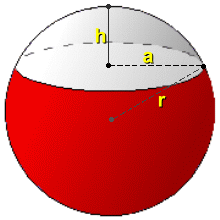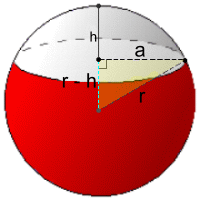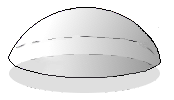
 In order to find the volume and surface area of a sphere's cap, here are the three variables we will need:
In order to find the volume and surface area of a sphere's cap, here are the three variables we will need:
to the centre of the circular base of the cap For simplification purposes we will first express a in terms of the other variables r and h.   In the yellow right triangle we use the Pythagorean Theorem:
In the yellow right triangle we use the Pythagorean Theorem:r2 = a2 + (r - h)2 a2 = r2 - (r - h)2 a2 = r2 - (r2 - 2rh + h2) a2 = r2 - r2 + 2rh - h2 a2 = 2rh - h2 Surface Area of Cap:  SA = area of outer side of curved part + area of circular base SA = area of outer side of curved part + area of circular baseSA = 2πrh + πa2 SA = 2πrh + π(2rh - h2) SA = 2πrh + 2πrh - πh2 SA = 4πrh - πh2 SA = πh(4r - h) Surface Area of Calotte:  SA = area of outer side of curved part
SA = area of outer side of curved part SA = 2πrh Volume of Cap: 
|